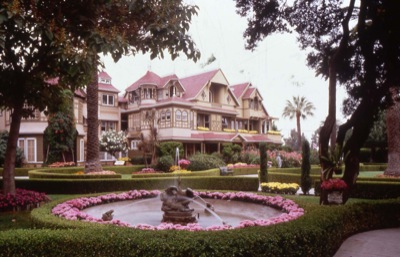
They have no turrets or moats, no drawbridges, armories or throne rooms. But across the country, majestic homes of enormous size and peculiar beauty are the American versions of castles.
Unlike their European counterparts, which came about in the Middle Ages, many of America’s castles are testaments to the wealth and innovation that grew from the Industrial Revolution of the 19th century. Several belonged to the wealthiest families of the day — Vanderbilts, du Ponts, Rockefellers, Carnegies — who built winter homes and summer cottages with size and luxury that remain extraordinary even today.
Thankfully, many of the grand homes of the age have been passed down or handed over to preservation institutions, and visitors can now walk through and experience touches of their incredible wealth and monumental architecture.
Along the way, groups that tour America’s castles will learn about the interesting and eccentric characters that created them.
Winchester Mystery House
San Jose, Calif.
One of America’s most imaginative and eclectic mansions, the Winchester Mystery House also comes with one of the strangest stories in the American West.
“The Winchester Mystery House was the house of the Winchester rifle heiress, Sarah Winchester,” said general manager Shozo Kagoshima. “She was advised that the death of her husband and daughter were because of all the people killed by Winchester rifles. She was told that the only way to appease the spirits was to start building this house and never stop.”
And so in 1884, Winchester purchased an eight-room farmhouse in San Jose and began building. During the 38 years that followed, she had crews of up to 18 carpenters working around the clock on building addition after addition onto the house.
By the time she died in 1922, the house contained 160 rooms, including some 40 bedrooms, 13 bathrooms, six kitchens and two ballrooms. Winchester used no master plan, and no blueprint of the mansion exists.
Today, the mansion is privately owned and open to the public for tours. During an hourlong visit, groups see 110 of the rooms, which feature period art and furnishings. They’ll also see some mystifying architectural elements.
“There are doors and windows that open onto walls, staircases that go up to ceilings and doors that open to 10-foot drop-offs,” Kagoshima said.
“There are two theories about these things: One says that she was trying to confuse the evil spirits. The other says that after 38 years of construction, she never bothered to go back and alter some of those details.”
www.winchestermysteryhouse.com
Vanderbilt Mansion
National Historic Site
Hyde Park, N.Y.
The Vanderbilt family built some of the most magnificent homes in the country, and one of their vacation homes, on the banks of the Hudson River, is now preserved as the Vanderbilt Mansion National Historic Site.
“It’s a mansion from 1898, and it’s on a 211-acre estate that overlooks the Hudson River,” said supervisory park ranger Allan Dailey. “It’s still largely intact to its original appearance, and it’s fully furnished as it was when the family was here. It was their spring and fall entertaining home — they would have referred to it as their country place.”
The 54-room Beaux Arts mansion is the smallest of the Vanderbilt homes but boasts numerous international artistic touches. Mrs. Vanderbilt’s bedroom was inspired by Marie Antoinette’s bedroom at the castle in Versailles, France; the dining room has a ceiling from a 16th-century Italian villa.
Guests who visit the home can also tour the grounds of the estate, with some of the oldest continuously maintained gardens and landscapes in the country. For more insight, groups can take a behind-the-scenes tour, which includes the servants’ quarters and an introduction to this period in American history.
“We use the house as a stage to talk about the social and economic changes in the country at that time,” Dailey said. “We’re talking about the rise of America as an economic superpower, about the railroads and how this came about at a time with small government, little regulation and little taxation.”
www.nps.gov/vama











